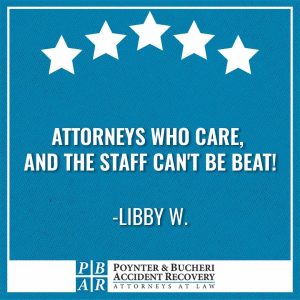
Openness and transparency in communication are core values at Poynter & Bucheri Accident Recovery. When you contact us about your T-bone accident, you’ll gain the knowledge and confidence to make informed decisions about your next steps.
Our goal is to empower you by putting your needs first and explaining what you need to know about your T-bone collision. We’ll make it a priority to clarify our fee structure up front and show you why it works to your best possible benefit.
We work on a contingency fee basis and our typical fee of 25% of the settlement amount is taken only at the end of your case. This client-friendly arrangement removes the barriers to seeking experienced, effective legal representation. We’ll be working diligently on your case throughout the process to help you recover compensation.
To inquire about your specific car accident claim, contact an Indianapolis T bone accident lawyer at Poynter & Bucheri Accident Recovery today for a free T-bone accident case review at 1-800-265-9881 or connect with us online.
What is a T-Bone Accident?
A T-bone accident is another term for a broadside crash or a side-impact car accident. This is what happens when one vehicle crashes directly into the side of another. If you imagine the scene from above, the two cars form the shape of an uppercase T, hence the name.
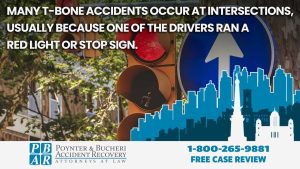
Many T-bone accidents occur at intersections, usually because one of the drivers ran a red light or stop sign. Another way T-bone accidents can occur at intersections is when a driver turns left into oncoming traffic.
These side-impact collisions can also happen when one driver pulls out into traffic from a side street or business parking lot regardless of a stop sign. An oncoming vehicle has no warning or time to brake.
How Common Are Side-Impact Car Accidents?
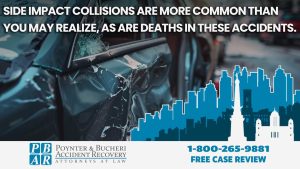
Side impact collisions are more common than you may realize, as are deaths in these accidents. According to the Insurance Institute for Highway Safety (IIHS), approximately 33% of total fatalities in passenger cars are due to side-impact multiple-vehicle collisions.
You are somewhat less likely to die in an SUV or truck side-impact crash than in a passenger-car T-bone accident. Just over 25% of all pickup truck and SUV fatalities are side-impact multiple-impact crashes. These vehicles are so popular that 80% of new vehicle purchases are SUVs and trucks.
Most Common Injuries in Side-Impact Collisions
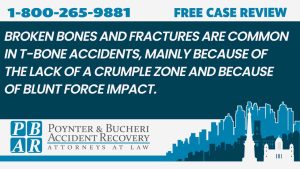
In a broadside car accident, the risk of serious injury depends on the types and angles of the forces involved. Injury pattern studies have found that if the vehicle being struck rolls towards the other vehicle as the crash occurs, injuries sustained will primarily be fractured bones in the femur or pelvis.
If the vehicle being struck is pushed away, severe injuries are more likely to the occupants’ heads and chests. This may include brain injuries, facial injuries, eye injuries, or traumatic brain injuries (TBIs) with expensive medical bills due to the high costs of treating head trauma.
In a side-impact car accident, the body is shaken violently from side to side. Occupants may be ejected from the vehicle, especially if it rolls over. Although less than 10% of vehicle accidents involve rollovers, 30% of all crash fatalities result from rollovers.
Broken bones and fractures are common in T-bone accidents, mainly because of the lack of a crumple zone and because of blunt force impact. Spinal cord damage with neck injuries or nerve damage are also common injuries in side-impact accidents.
Why Are the Injuries in a Side-Impact Collision So Severe?
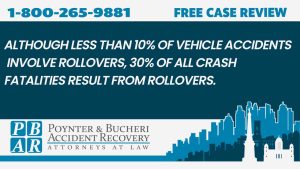
A T-bone crash is often most severe when vehicles are traveling at fairly high rates of speed and the drivers involved aren’t slowing down. Examples include near a red light, under a flashing traffic light, or around stop signs failing to keep drivers from crossing into traffic. These car accidents present a high risk of severe injury, like when people experience spinal cord or brain damage in broadside accidents.
In a broadside car crash where one vehicle hits another on the side, the victim’s vehicle doesn’t have the advantage of several feet of bumper, dashboard, or engine to cushion the blow, like in rear-end collisions. Although head-protecting and side airbags reduce the fatality risk for a driver in a driver-side crash by more than 35%, they are not present in all cars that are in side-impact crashes.
How Will a T-Bone Accident Attorney Help Me Determine Fault?
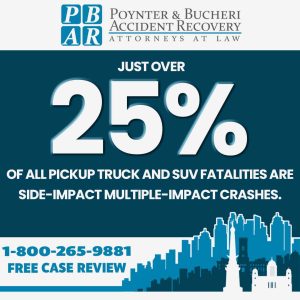
T-bone crashes are confusing for the people involved, but experienced accident attorneys have seen it all. A T-bone accident lawyer will help you understand the individual circumstances and the impact of the other driver’s negligence. They’ll describe how the police and courts may view your accident and explain your legal options, including the role of insurance coverage in your quest to obtain compensation.
Your personal injury attorney can describe Indiana’s modified comparative fault negligence system, which means that one or more individuals can share in the liability for an accident. One driver’s negligence doesn’t mean they’ll have all the blame. Each party’s contribution to the accident factors into the dollar amount of damages he or she can recover.
If an individual’s percentage of fault is greater than 50%, he or she is barred from T-bone accident recovery. If the at-fault driver fails to prove they weren’t at fault and is found to hold at least 51% to blame, he or she cannot seek compensation.
Partial blame doesn’t end your claim. If you are held partially liable at 50% or less fault, your compensation would be reduced by a proportional amount, but you can still recover valuable accident compensation.
Keep in mind that there could be parties to your claim who are not obvious at first. Other parties may include:
- The at-fault driver’s employer
- An auto repair shop or manufacturer
- A government agency
- A construction company or repair crew
As you can see, the calculation of full and fair compensation is complex. Consult an experienced car accident attorney who has experience with T-bone personal injury cases.
What to Do if You Are Involved in a T-Bone Accident
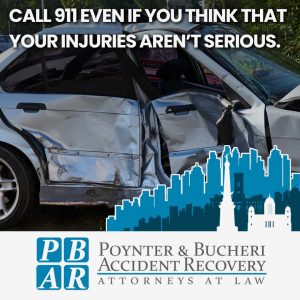
After your side-impact collision, check for injuries. Call 9-1-1 even if you think that your injuries aren’t serious. For many T-bone accident victims, their injuries aren’t immediately apparent but are serious and need a doctor’s evaluation.
Take pictures of the accident scene. Include landmarks for reference, like road signs and traffic signals. Photograph the damage to both vehicles.
Exchange insurance information with the other driver, but don’t admit fault. After the police have investigated, make sure that you get a copy of the police report.
Contact your insurance company but not the other person’s insurance company. Instead, direct them to your T-bone accident lawyer.
Seek immediate medical attention and save records of all medical care and documents. Follow your doctor’s orders and track your medical costs, including over-the-counter treatments.
Document all expenses as well as lost wages that you incurred as a result of the T-bone collision. Keep a journal about your journey and hardships and share it with your personal injury lawyer.
What Impacts the Value of My T-Bone Accident Claim?
After it has been established that the other driver was responsible for the T-bone collision, it’s time to start negotiating a fair settlement for you. Many factors could impact the value of your award.
Typical Factors Affecting Claims in T-Bone Accidents
- Your types of injuries
- How severe your injuries are
- Whether there were vehicle occupants involved
- What kinds of financial losses you have incurred
- How much evidence you have and how clear it is
- The impact of issues like distracted driving or drunk driving
- Your percentage of partial liability for the broadside collision
- Types of extra insurance available, like underinsured motorist coverage
Common Economic Damages in T-Bone Car Accidents:
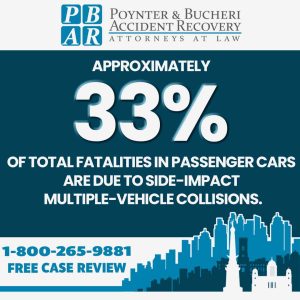
- Medical expenses
- Property damage
- Lost income
- Travel expenses to medical appointments
- Medical equipment, such as crutches or a cane
- Physical therapy
- Medications
- Other out-of-pocket costs
Common Non-economic Damages in T-Bone Collisions
- Physical pain
- Loss of enjoyment of life
- Emotional distress
- Permanent impairments
- Mental anguish
Indiana’s personal injury laws do not contain a formula for calculating pain and suffering damages. You’ll need an experienced Indianapolis T-bone attorney to help establish the value of your claim and explain your legal options.
What is the Statute of Limitations for T-Bone Collisions?
The Statute of Limitations for T bone collisions and for any Indiana personal injury lawsuit is two years, meaning you must start a T-bone accident claim or personal injury lawsuit within that time or you’ll lose your chance.
Poynter & Bucheri T-Bone Accident Lawyers
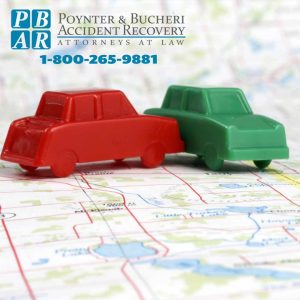
Please don’t let the pain and trauma of your accident delay your determination to speak to a qualified Indiana T-bone collision attorney about financial compensation.
Over time, memories fade and evidence is lost. Act fast to preserve vital information and pursue the high value of your T-bone accident claim. We’re here to help you make positive progress!
Call Poynter & Bucheri Accident Recovery today for a free case evaluation by phone at 1-800-265-9881, or contact us online for your free consultation.
